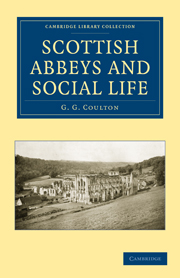Book contents
- Frontmatter
- Contents
- LIST OF ILLUSTRATIONS
- Preface
- Chapter I Celtic Monachism
- Chapter II The Monastic Rules
- Chapter III Monastic Revenues
- Chapter IV How Endowments Came (I)
- Chapter V How Endowments Came (II)
- Chapter VI Monks and Parishes (I)
- Chapter VII Monks and Parishes (II)
- Chapter VIII Charity (I)
- Chapter IX Charity (II)
- Chapter X Monk and Peasant (I)
- Chapter XI Monk and Peasant (II)
- Chapter XII Monastic Housekeeping
- Chapter XIII Church and Scriptorium
- Chapter XIV The Monastic Chronicler
- Chapter XV Schools
- Chapter XVI Art and Learning
- Chapter XVII Professions and Business
- Chapter XVIII Visitation (I)
- Chapter XIX Visitation (II)
- Chapter XX A Voice from the Cloister
- Chapter XXI Conclusion
- Appendixes
- List of Authorities
- Index
Chapter XXI - Conclusion
Published online by Cambridge University Press: 05 August 2011
- Frontmatter
- Contents
- LIST OF ILLUSTRATIONS
- Preface
- Chapter I Celtic Monachism
- Chapter II The Monastic Rules
- Chapter III Monastic Revenues
- Chapter IV How Endowments Came (I)
- Chapter V How Endowments Came (II)
- Chapter VI Monks and Parishes (I)
- Chapter VII Monks and Parishes (II)
- Chapter VIII Charity (I)
- Chapter IX Charity (II)
- Chapter X Monk and Peasant (I)
- Chapter XI Monk and Peasant (II)
- Chapter XII Monastic Housekeeping
- Chapter XIII Church and Scriptorium
- Chapter XIV The Monastic Chronicler
- Chapter XV Schools
- Chapter XVI Art and Learning
- Chapter XVII Professions and Business
- Chapter XVIII Visitation (I)
- Chapter XIX Visitation (II)
- Chapter XX A Voice from the Cloister
- Chapter XXI Conclusion
- Appendixes
- List of Authorities
- Index
Summary
And now, in conclusion, let me try to balance the good and the evil that have been brought forward in these lectures.
Monasticism, in its most characteristic forms, ran to extremes. As early as St Augustine's day, in the infancy of the institution, it was noted that nothing was better than a good monk, nothing worse than a bad. In the restricted canvas which these lectures have allowed for so large a subject, I have tried to keep two main questions in mind. In the first place, why did monasticism become so powerful that it took to itself the whole name of Religion, and that conversion came to mean retirement into the cloister? Secondly, how can we explain the reaction? For reaction there certainly has been. That which, in the Middle Ages, seemed so natural to every truly pious mind, has now become highly exceptional. Monasticism is not dead; far from it. It lives on in every country of today; and a distinguished Benedictine scholar who has lately sent me two very frank studies in monastic history ends his letter with these words: “But all the miseries of the past change nothing in my ideal of true monasticism”. And he is right; those words come well from the pen of a man whose own life has done honour to his profession. Monasticism is not dead; yet certainly a great deal of what was most characteristic in medieval monasticism is dead; and, if I may express my own personal belief, dead for ever.
- Type
- Chapter
- Information
- Scottish Abbeys and Social Life , pp. 250 - 260Publisher: Cambridge University PressPrint publication year: 2010First published in: 1933

